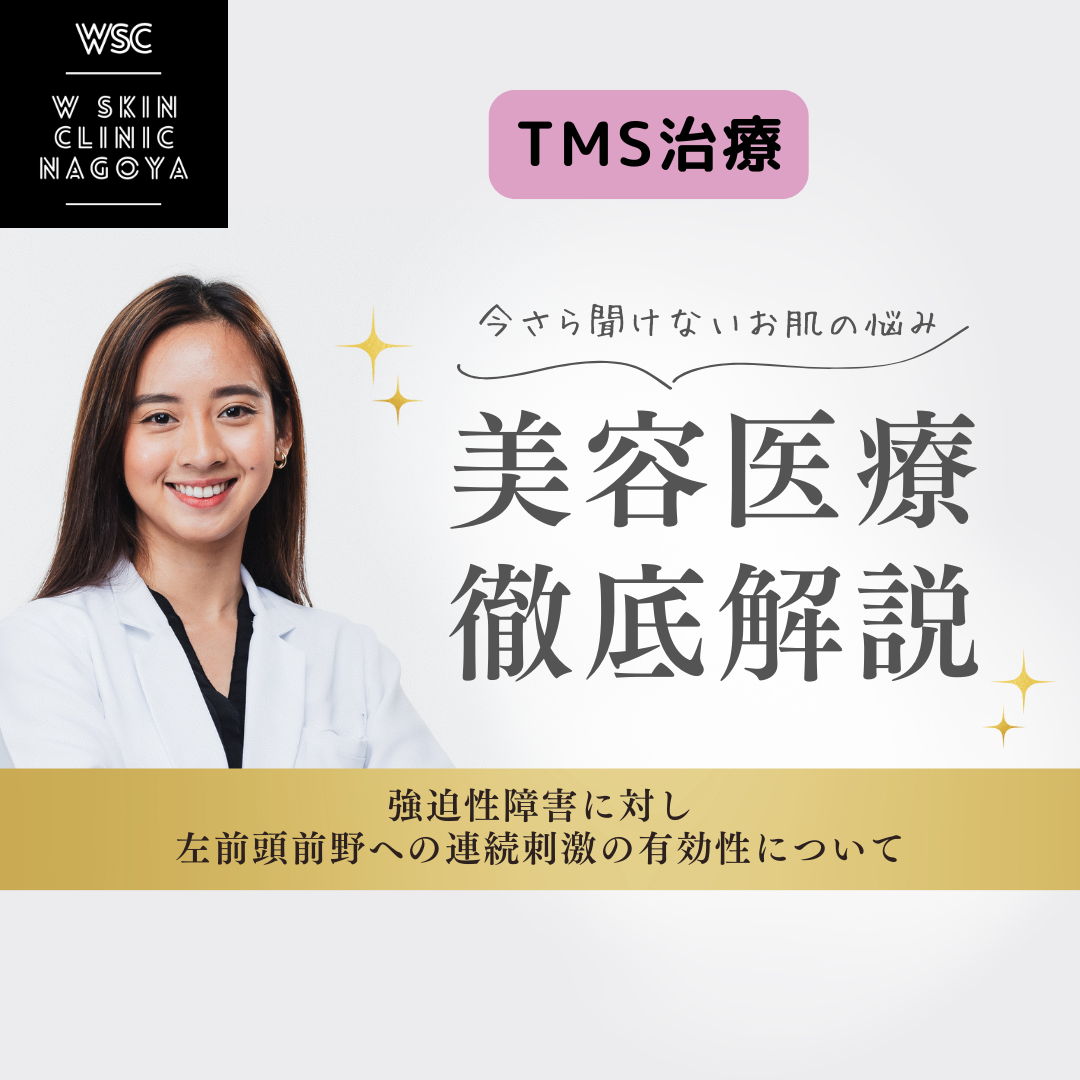NEWSお知らせ
2024.11.30|ブログ
TMS治療、左前頭前野に対する連続刺激で、強迫性障害に対して有効性は発揮するか?その根拠は?名古屋の美容皮膚科医が解説

TMS治療、左前頭前野に対する連続刺激で、強迫性障害に対して有効性は発揮するか?その根拠は?名古屋の美容皮膚科医が解説
こんにちは、Wスキンクリニック名古屋、院長の加藤晃司です。
今回は、TMS治療、左前頭前野に対する連続刺激で、強迫性障害に対して有効性は発揮するか?その根拠は?について解説します。
TMS治療における左前頭前野(DLPFC: Dorsolateral Prefrontal Cortex)への連続刺激は、強迫性障害(OCD: Obsessive-Compulsive Disorder)の治療にも一定の有効性を示します。以下にその根拠とメカニズムを詳細に説明します。
- 強迫性障害(OCD)と左前頭前野の関係
OCDにおける脳の異常
OCDは、前頭皮質-基底核-視床回路(Cortico-Striato-Thalamo-Cortical circuit, CSTC)の過剰な活性化が主な原因とされています。
特に、前頭前野と扁桃体、基底核(尾状核、被殻)との連携異常が、強迫観念や強迫行為を引き起こすと考えられます。
左DLPFCは感情制御や意思決定に関与し、過剰な不安や強迫的な思考を抑制する役割を担います。
左DLPFCの低活動
OCD患者では、左DLPFCの活動低下が報告されており、この領域の活性化を促進することで症状改善が期待されます。
- TMS治療のメカニズム(左DLPFCへの刺激)
(1) 高頻度TMS(10~20Hz)による神経可塑性の促進
高頻度刺激は、左DLPFCの活動を増加させ、機能低下を補正します。
シナプス可塑性(長期増強、LTP)を誘発し、脳内ネットワーク全体の調和を改善します。
(2) 神経伝達物質の分泌促進
高頻度刺激により、セロトニン、ドーパミン、ノルアドレナリンなどの神経伝達物質の分泌が増加。
これにより、不安感の軽減や、強迫的な思考・行動の制御が促されます。
(3) CSTC回路のバランス調整
左DLPFCへの刺激は、前頭前野と基底核の過剰な相互作用を抑制。
扁桃体や基底核からの過剰な信号が緩和され、強迫症状の減少に寄与します。
- 臨床研究による根拠
(1) 左DLPFCへの高頻度TMSの有効性
ランダム化比較試験(RCT)では、左DLPFCへの高頻度刺激がOCD患者の症状を有意に改善する結果が報告されています。
反応率(症状の50%以上改善):20~30%。
寛解率(症状がほぼ消失):10~20%。
(2) 繰り返し治療の効果
1回の治療セッションではなく、1~2か月の継続的な治療が、長期的な症状改善に寄与することが示されています。
(3) 他部位刺激との比較
補足運動野(SMA)への低頻度刺激がOCD治療に有効であることも知られています。
左DLPFCへの高頻度刺激は、不安症状や抑うつ症状の併発例に特に効果的。
- TMS治療の効果を高める要因
(1) 症状のタイプに応じたアプローチ
強迫観念が主症状:左DLPFCへの高頻度刺激が効果的。
強迫行為が主症状:補足運動野(SMA)への低頻度刺激との併用が有効。
(2) 他の治療との併用
薬物療法(SSRI、クロミプラミン)と組み合わせることで、相乗効果が期待されます。
認知行動療法(CBT)とTMSを併用すると、治療効果の持続性が向上。
(3) 刺激パラメータの調整
刺激頻度:10Hz~20Hzの高頻度刺激。
セッション時間:20~40分。
期間:週5回を1~2か月継続。
- TMS治療の利点と限界
利点
非侵襲的で副作用が少なく、薬物治療が難しい患者に適応可能。
他の脳部位(SMA、ACC)への刺激と併用することで、多角的なアプローチが可能。
限界
反応率や寛解率は個人差があり、全ての患者に劇的な改善をもたらすわけではない。
症状の重症度や長期的な治療継続が必要。
- 施術スケジュールの例
初期治療(1~4週目):
左DLPFCに10Hzの高頻度刺激、1日3000パルス、週5回実施。
症状の変化を評価し、必要に応じて調整。
維持治療(5~8週目以降):
週2~3回の刺激に減らし、効果を持続。
他部位との併用:
SMAへの低頻度刺激を追加し、強迫行為の抑制を図る。
まとめ
左DLPFCへの高頻度TMSは、強迫性障害における強迫観念や不安の軽減に有効であることが示されています。その根拠は、DLPFCの機能活性化が脳内ネットワークのバランスを改善し、OCDの根本的な病態(CSTC回路の異常)にアプローチする点にあります。特に、不安症状や抑うつ症状を伴うOCD患者には、左DLPFCへの刺激が効果的です。
ただし、症状のタイプに応じて補足運動野(SMA)など他部位との併用が必要な場合もあり、専門医の診断と治療計画が重要です。
TMS治療はこちら
https://www.w-clinic-nagoya.com/tms
Wスキンクリニック名古屋でのエクソソーム治療はこちら
https://www.w-clinic-nagoya.com/acne/exosome
NMN点滴はこちら
https://www.w-clinic-nagoya.com/beauty-drip/nmn
高濃度ビタミンC点滴はこちら
https://www.w-clinic-nagoya.com/beauty-drip/vitamin-c
*当院では
NMNは一般社団法人NMN医療研究会、エクソソームはセルソース株式会社のM2P-エクソソームを使用しています。
当院では無料でスタッフカウンセリングを行なっております。
お気軽にご予約くださいませ
Wスキンクリニック名古屋 (美容皮膚科)
https://www.w-clinic-nagoya.com/
〒461-0005 愛知県名古屋市東区東桜 2-4-1 第3コジマビル6F
TEL 052-7377-7117(10:00~19:00)
LINE ID @w.nagoya
高岳駅より徒歩4分 / 新栄町駅より徒歩5分
お車でお越しの方
名鉄協商パーキングチケットをお渡しいたしますので、クリニック近くのパーキングをご利用ください。
ご予約、お問合せ、Wスキンクリニック名古屋公式LINEからも可能です。
LINE ID : @w.nagoya
友達追加は↓から
Wスキンクリニック名古屋公式インスタ↓
https://www.instagram.com/w.skinclinic.nagoya?igsh=NHhoODFnaXB2b2ll&utm_source=qr
Wスキンクリニック院長 加藤晃司インスタ↓
https://www.instagram.com/w.skin.nagoya.kojikato?igsh=aW9nbWZwNjNjZ3pz&utm_source=qr
TMS Treatment: Effectiveness of Continuous Stimulation to the Left DLPFC for OCD
Explained by Dr. Koji Kato, W Skin Clinic Nagoya
Transcranial Magnetic Stimulation (TMS) targeting the left dorsolateral prefrontal cortex (DLPFC) has demonstrated potential effectiveness in treating Obsessive-Compulsive Disorder (OCD). This treatment works through several neurobiological mechanisms, backed by clinical research. Below is a detailed explanation of the rationale and evidence supporting this approach.
- The Role of the Left DLPFC in OCD
Brain Abnormalities in OCD
Cortico-Striato-Thalamo-Cortical (CSTC) Circuit Dysfunction:
OCD is characterized by hyperactivity in the CSTC loop, particularly involving the prefrontal cortex, amygdala, and basal ganglia.
DLPFC's Role:
The left DLPFC is essential for emotional regulation and decision-making. Its underactivity in OCD patients is linked to heightened anxiety and obsessive thoughts.
Impact of DLPFC Dysfunction
Decreased activity in the left DLPFC impairs the ability to suppress intrusive thoughts and regulate emotional responses, leading to compulsive behaviors.
- Mechanism of TMS on the Left DLPFC
(1) High-Frequency Stimulation and Neuroplasticity
Stimulation Frequency: High-frequency TMS (10–20 Hz) enhances the activity of the left DLPFC.
Synaptic Plasticity: By inducing long-term potentiation (LTP), TMS improves connectivity in the CSTC circuit, restoring normal brain function.
(2) Neurotransmitter Regulation
Increased Neurotransmitter Levels:
TMS boosts serotonin, dopamine, and norepinephrine, alleviating anxiety and reducing obsessive-compulsive behaviors.
(3) Balancing the CSTC Circuit
Stimulating the left DLPFC reduces excessive signaling within the CSTC loop, mitigating obsessive-compulsive symptoms.
- Clinical Evidence Supporting TMS for OCD
(1) Randomized Controlled Trials (RCTs)
High-frequency stimulation of the left DLPFC has shown statistically significant improvements in OCD symptoms.
Response Rate: 20–30% of patients experience a 50% or greater reduction in symptoms.
Remission Rate: 10–20% achieve near-complete remission.
(2) Long-Term Benefits with Repeated Sessions
Studies suggest that 4–8 weeks of continuous treatment yield sustained improvements in OCD symptoms.
(3) Comparison with Other Brain Regions
While the supplementary motor area (SMA) is another effective target for OCD, the left DLPFC stimulation is particularly beneficial for patients with co-occurring anxiety or depression.
- Factors Enhancing TMS Effectiveness
(1) Symptom-Specific Targeting
Obsessions (Intrusive Thoughts): Left DLPFC stimulation is highly effective.
Compulsions (Repetitive Behaviors): Combining DLPFC stimulation with SMA targeting may improve outcomes.
(2) Combining Therapies
Medications:
SSRIs or clomipramine enhance TMS outcomes.
Cognitive Behavioral Therapy (CBT):
Simultaneous CBT supports sustained improvement by addressing thought patterns.
(3) Optimizing Parameters
Stimulation Frequency: 10–20 Hz.
Session Duration: 20–40 minutes.
Treatment Duration: Daily sessions over 4–8 weeks.
- Benefits and Limitations of TMS for OCD
Benefits
Non-Invasive: No surgery or systemic side effects.
Adjunctive Therapy: Effective for medication-resistant OCD.
Limitations
Variable Response: Not all patients achieve significant improvement.
Ongoing Maintenance: Regular follow-up sessions may be necessary for long-term benefits.
- Recommended Treatment Schedule
Initial Phase (Weeks 1–4)
Frequency: Daily high-frequency TMS (10 Hz) targeting the left DLPFC.
Pulse Count: 3,000 pulses per session.
Maintenance Phase (Weeks 5–8)
Frequency: Reduce to 2–3 sessions per week.
Combination Treatments
SMA Stimulation: Add low-frequency SMA stimulation for compulsive symptoms.
Summary
TMS targeting the left DLPFC effectively alleviates OCD symptoms, particularly obsessive thoughts and anxiety. The mechanism involves restoring normal activity in the CSTC circuit, boosting neurotransmitter levels, and reducing circuit hyperactivity. Clinical evidence supports its efficacy, especially when combined with SMA stimulation, pharmacotherapy, or CBT.
For optimal results, personalized treatment plans based on symptom type and severity are essential. If you are considering TMS for OCD, consult a specialist for a comprehensive evaluation and tailored approach.




